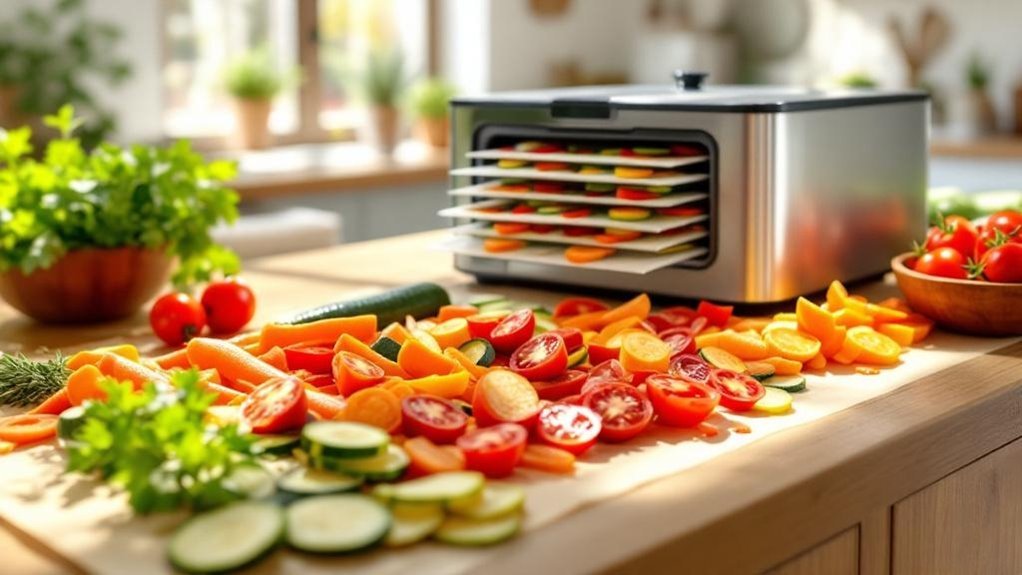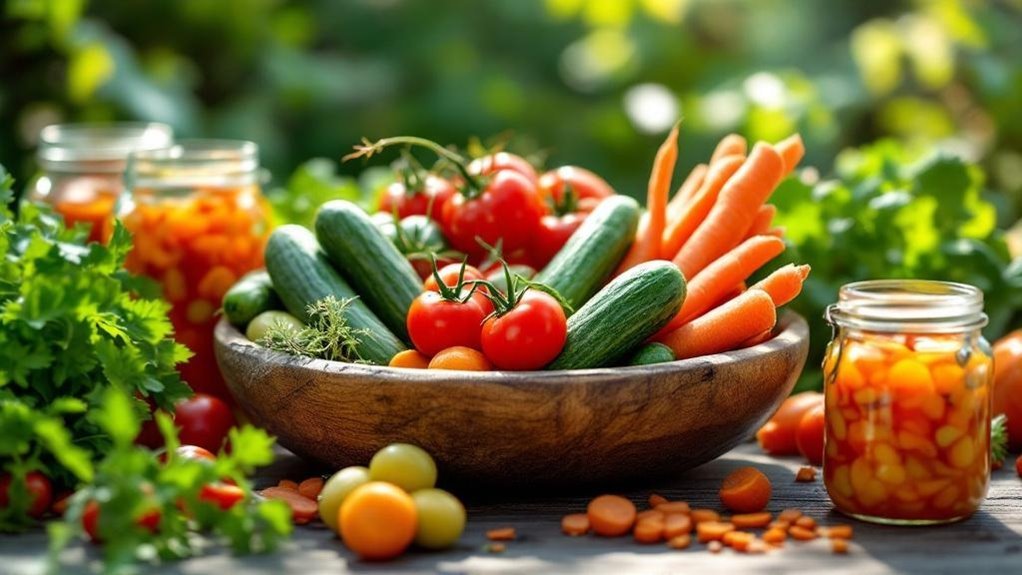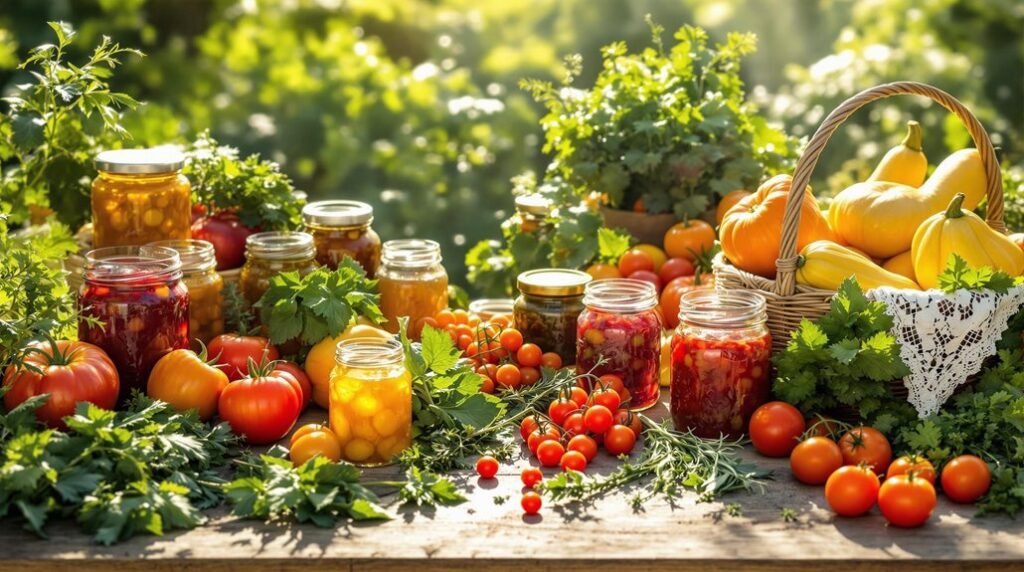Think of your garden harvest as a fleeting sunset—vibrant but soon gone. You want to hold onto that freshness and flavor as long as possible, but it’s not always clear how. Luckily, there are practical ways to extend the life of your fruits and vegetables, from simple storage tricks to creative preservation techniques. Keep going, and you’ll find methods that suit your needs, helping your hard work pay off well beyond the growing season.
Store Vegetables Fresh
When you store vegetables fresh, you’ll want to tailor the environment to each type.
Root vegetables like carrots and potatoes do best in a cool, dark, and humid place, making them ideal for long-term storage—often lasting between one to six months.
Onions and garlic, on the other hand, prefer a cool, dry, and dark spot at room temperature to stay fresh for months.
Leafy greens like lettuce need a high-humidity environment, such as your refrigerator’s vegetable crisper, but only last a few days.
To preserve your harvest effectively, keep moisture low for most vegetables to prevent mold and avoid storing ethylene-producing fruits nearby, as they can speed up spoilage.
Freeze Your Homegrown Fruit and Vegetables
Since freezing preserves color, flavor, and nutrients effectively, you can keep your homegrown fruits and vegetables fresh for up to a year. To freeze properly, wash produce well and use suitable freezer bags or containers to avoid freezer burn. Some veggies like zucchini and spinach need blanching before freezing to maintain flavor and texture. Freeze berries by spreading them on a cookie sheet first to prevent clumping. Avoid freezing watery vegetables like lettuce and cucumber—they don’t hold up well.
| Produce Type | Freezing Tip |
|---|---|
| Zucchini, Spinach | Blanch before freezing |
| Berries | Freeze single layer first |
| Lettuce, Cucumber | Avoid freezing |
| General Fruits | Wash and pack tightly |
| General Vegetables | Use proper containers |
Freezing is a reliable preservation method to keep flavor and nutrients intact.
Dehydrate or Dry Your Vegetables

Freezing isn’t the only way to extend the life of your garden produce—you can also dehydrate or dry your vegetables to preserve them.
Dehydrating helps retain nutrients while cutting down weight and volume, making storage easier and shelf life longer. To get started, follow these steps:
Dehydrating preserves nutrients, reduces bulk, and extends shelf life for easier storage of your garden bounty.
- Slice vegetables into uniform pieces for even drying.
- Use a dehydrator at around 135°F for the best, energy-efficient results.
- Dry until vegetables are crispy, ensuring moisture is fully removed.
- Store dried vegetables in airtight containers to keep quality and prevent moisture absorption.
Common veggies for drying include herbs, tomatoes, potatoes, and turnips.
Quick Refrigerator Pickling
Quick refrigerator pickling lets you preserve a variety of vegetables like cucumbers, carrots, and radishes without special equipment.
This method uses a simple brine made from water, vinegar, sugar, and salt, enhanced with fresh herbs and spices like dill or garlic to boost flavor.
Cut your veggies into the shapes you prefer, then submerge them in the pickling solution and refrigerate. Your pickled produce will develop tangy, crisp flavors after just 24 hours.
By storing these in airtight containers, you can make your preserved food last up to three months.
Quick refrigerator pickling is ideal for small batches, helping you enjoy fresh garden harvests longer while reducing waste.
It’s a fast, convenient way to keep your veggies tasty and ready to eat.
Ferment Food From Your Garden

When you ferment food from your garden, you harness beneficial bacteria and yeasts that not only preserve your vegetables but also boost their nutritional value with probiotics.
To get started with fermentation, follow these key steps:
- Prepare a precise brine of salt and water to create the right environment for fermentation.
- Pack your chosen vegetables—like cabbage, carrots, or cucumbers—into a Mason jar.
- Use fermentation lids to seal the jar, keeping out oxygen while allowing gases to escape.
- Store the jar in a cool, dark place for several weeks to develop complex flavors and textures.
Fermented foods last for months, enhancing digestion and nutrient absorption thanks to the beneficial bacteria thriving in your preserved vegetables.
Canning Fruits or Vegetables
Canning fruits or vegetables lets you enjoy your garden’s bounty long after the harvest season ends. You’ll need to choose between water bath canning for high-acid foods like tomatoes and fruits, or pressure canning for low-acid foods such as beans and corn. Always use tested recipes and proper equipment like glass jars and a jar lifter to guarantee safety and quality. This method can preserve your produce for up to a year on your shelf.
| Food Type | Canning Method | Safety Tip |
|---|---|---|
| High-acid fruits | Water bath | Follow USDA tested recipes |
| Tomatoes | Water bath | Use fresh, ripe produce |
| Low-acid veggies | Pressure canning | Process at recommended pressure |
| Beans, corn | Pressure canning | Avoid botulism with correct method |
Preserve Fresh Fruits Into Jams and Jellies
Preserving fresh fruits into jams and jellies lets you capture the vibrant flavors of your garden in a sweet, spreadable form.
To preserve fruits effectively, follow these steps:
- Select fresh, high-quality fruits for the best homemade jam flavor.
- Combine fruits with sugar and pectin, using a tested recipe to get the right texture and sweetness.
- Sterilize canning jars thoroughly and process them correctly to store your jam safely for up to a year.
- For an easier option, try freezer jam by mixing fruit, sugar, and pectin, then storing it in freezer-safe containers.
Store Root Vegetables in a Cellar
Anyone looking to keep root vegetables fresh for months should consider storing them in a cellar.
Root vegetables like carrots, potatoes, beets, and turnips thrive in a cool, dark, humid environment, ideally between 32°F and 40°F. A properly maintained cellar provides these conditions, making it perfect for long-term storage.
To prevent sprouting and shriveling, pack your root vegetables in sand or sawdust. Proper ventilation is essential to avoid mold growth and keep the air circulating.
Make sure to check your stored produce regularly, removing any that show signs of rot or sprouting.
With these steps, your root vegetables will stay fresh and edible well beyond harvest, maximizing your garden’s bounty throughout the season.
Make Pesto From Garden Herbs
While fresh herbs won’t last forever, you can extend their flavor by turning them into pesto.
Making homemade pesto from your garden harvest is a smart way to make your herbs last longer and enjoy their vibrant taste year-round. Here’s how to do it:
- Gather 2 cups of packed fresh herbs like basil, parsley, or cilantro.
- Blend with 1/2 cup nuts, 1/2 cup grated Parmesan, 2-3 garlic cloves, and 1/2 cup olive oil until smooth.
- Store pesto in an airtight container in the fridge for up to a week; add a thin olive oil layer on top to preserve color.
- Freeze pesto in ice cube trays for convenient, long-lasting portions.
This method helps you make the most of your garden harvest while preserving its fresh flavors.
Create Fruit Leather and Snack Foods
If you want to turn your garden’s surplus fruit into delicious, long-lasting snacks, making fruit leather is a great choice.
To make homemade fruit leather, puree your fresh fruit, optionally blending different varieties or adding spices like cinnamon or vanilla for extra flavor.
Spread the puree thinly on a dehydrator tray or baking sheet and dry it at low temperatures for 6 to 12 hours, depending on moisture content.
Once dry, cut the fruit leather into strips or roll it up for easy storage.
This method lets you preserve your harvest while creating a healthy, chewy snack that lasts for months.
Frequently Asked Questions
How Do You Preserve Garden Harvest?
You can preserve your garden harvest by freezing, canning, pickling, dehydrating, or fermenting. Each method keeps your produce fresh longer, so choose one that fits your taste and storage needs to enjoy your crops year-round.
How to Store Fresh Picked Garden Vegetables?
You should store fresh-picked vegetables based on their type: keep root veggies cool and humid, onions ventilated, leafy greens refrigerated in perforated bags, and separate ethylene-producing fruits to prevent spoilage in nearby produce.
How to Preserve the Harvest?
You might think preserving takes too much effort, but you can easily freeze, can, pickle, dehydrate, or ferment your harvest. These methods keep your produce fresh longer, saving money and letting you enjoy your garden’s bounty year-round.
What Are Simpler Ways Than Canning to Preserve Your Garden Harvest?
You can freeze your harvest after blanching veggies, quick-pickle with vinegar and salt, dehydrate fruits and herbs, make freezer jam, or prepare pesto to freeze in trays. These methods require less effort than canning.
Final Thoughts
Did you know that freezing can preserve up to 90% of your garden’s nutrients? By choosing the right preservation methods—whether freezing, dehydrating, or pickling—you’ll enjoy fresh flavors and nutrition all year long. Don’t let your hard work go to waste; tailor your storage to each type of produce for the best results. With these techniques, you’ll make the most of your harvest and savor your garden’s bounty anytime you want.
